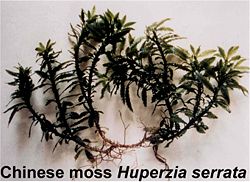Huperzine A Complexed with Acetylcholinesterase
From Proteopedia
(Difference between revisions)
(New page: 250px {{STRUCTURE_1vot| PDB=1vot | SCENE= }} '''3D Structure of Huperzine A Complexed with Acetylcholinesterase''' (see also [[AChE inhibitors and substrates (...) |
|||
| Line 1: | Line 1: | ||
| - | + | <StructureSection load='1vot' size='400' side='right' scene='1vot/Com_view/1' caption=''> | |
| - | + | [[Image:1vot.jpg|left|200px]] | |
'''3D Structure of Huperzine A Complexed with Acetylcholinesterase''' | '''3D Structure of Huperzine A Complexed with Acetylcholinesterase''' | ||
| Line 11: | Line 11: | ||
The structure of HupA shows some similarity to other known [[AChE inhibitors and substrates]]. The molecule is fairly rigid and contains an [http://en.wikipedia.org/wiki/Aromaticity aromatic] system as well as a [http://en.wikipedia.org/wiki/Amine primary amino group] that is probably [http://en.wikipedia.org/wiki/Protonation protonated] at physiological [http://en.wikipedia.org/wiki/PH pH]. Various suggestions have been made with respect to its orientation within the active site of AChE, and with respect to the amino acid residue with which its putative [http://en.wikipedia.org/wiki/Pharmacophore pharmacophoric] groups might interact. Solution of the 3D structure of a complex of HupA with AChE would permit unequivocal resolution of this issue and it would also provide a rational basis for structure-related [http://en.wikipedia.org/wiki/Drug_design drug design] aimed at developing synthetic analogues of HupA with improved therapeutic properties. | The structure of HupA shows some similarity to other known [[AChE inhibitors and substrates]]. The molecule is fairly rigid and contains an [http://en.wikipedia.org/wiki/Aromaticity aromatic] system as well as a [http://en.wikipedia.org/wiki/Amine primary amino group] that is probably [http://en.wikipedia.org/wiki/Protonation protonated] at physiological [http://en.wikipedia.org/wiki/PH pH]. Various suggestions have been made with respect to its orientation within the active site of AChE, and with respect to the amino acid residue with which its putative [http://en.wikipedia.org/wiki/Pharmacophore pharmacophoric] groups might interact. Solution of the 3D structure of a complex of HupA with AChE would permit unequivocal resolution of this issue and it would also provide a rational basis for structure-related [http://en.wikipedia.org/wiki/Drug_design drug design] aimed at developing synthetic analogues of HupA with improved therapeutic properties. | ||
| - | |||
| - | <applet load='1vot' size='500' frame='true' align='right' | ||
| - | scene='1vot/Com_view/1' /> | ||
==Structure== | ==Structure== | ||
Revision as of 13:11, 7 June 2012
| |||||||||||
Proteopedia Page Contributors and Editors (what is this?)
Joel L. Sussman, Alexander Berchansky, Michal Harel, Jaime Prilusky


